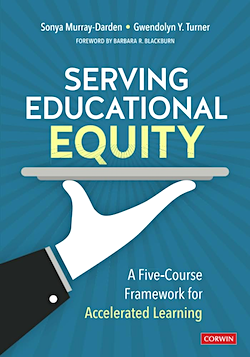We Need to Accelerate, Not Remediate Learning
By Sonya Murray-Darden and Gwendolyn Y. Turner
All students can learn and achieve at high levels. We’ve enjoyed front-row seats, observing students who have shown their genius potential despite academic challenges. We’ve seen the evidence that the successful journey to learning recovery is a matter of acceleration, not remediation.
Over the past few years, there have been many conversations in education and policy circles about disrupted and unfinished learning.
The Education Recovery Scorecard reports that these disruptions have resulted in children experiencing learning losses in core subjects such as reading and math, especially for schools in high-poverty areas (Fahle, 2022).
While we acknowledge these issues and the impact on students’ social, emotional, and academic learning opportunities, we have personally witnessed students succeed on grade-level concepts through robust teaching and learning when educators hold high expectations and execute strategies for accelerated learning.
The solution isn’t getting students “caught up”
As we visited classrooms, we witnessed educators grappling with the challenges of unfinished learning. We observed teachers’ anxiety and urgency in meeting students’ learning needs. We heard teacher comments like, “My students cannot do this work,” and “We need to get students caught up at grade level.”
We remind educators that there is no quick fix to addressing unfinished teaching and learning. In our book Serving Educational Equity: A Five-Course Framework for Accelerated Learning, we suggest teachers initiate their journey by clearly defining, embracing, and implementing acceleration.
Historically, remediation approaches have been used to address unfinished learning and offer just-in-case instruction (click image below to enlarge).
Educators must use relevant, timely instructional approaches to accelerate students’ learning. To provide every student with access to grade-level content and rigorous learning tasks, we agree with Dr. Barbara Blackburn’s position that each student should be supported and expected to demonstrate learning at high levels.
The chart below presents traditional methods that emphasize just-in-case learning compared to just-in-time learning.
Impact of Traditional Remediation
versus Acceleration Approaches
Adapted from “Serving Educational Equity: A Five Course Framework for Accelerated Learning.” Murray-Darden & Turner, (2023).
Planning and evaluating acceleration
In our book we assert that planning for equitable, accelerated learning is analogous to preparing a meal. Similar to how a chef selects the menu, gathers ingredients, and arranges the occasion, educators choose aligned curricula to prioritize learning, organize and internalize instruction, and plan for opportunities that advance learning.
At the school and building levels, educators must explore how they will assess current conditions for acceleration and promote students’ learning regardless of ability level. Our planning chapter offers a Strengths, Weaknesses, Opportunities, and Threats (SWOT) adaptive tool to support educators as they accelerate students’ learning. As educators plan for acceleration, we ask that they reflect and respond to the questions on the checklists:
Then we use the checklist below to reflect on how we’ll plan to incorporate acceleration in the classroom.
Acceleration activities to advance learning
We propose that educators integrate learning activities and strategies that require students to engage in problem-solving, critical reading, and reflective writing as they explore concepts and use their metacognitive skills with grade-level content. Each of the following acceleration activities is provided in our Time to Dig In Tools section of our book.
We recommend that as teachers implement the above instructional changes, they (a) discuss acceleration with all stakeholders including parents as well as their own students; (b) examine their current instructional program in order to identify assets and barriers to implementing acceleration; (c) review and adapt their current instructional resources to ensure that these address the diverse needs of learners, and (d) teach for robust understanding by scaffolding support as needed while allowing students to engage in productive struggle.
Students are encouraged to learn from mistakes, to explain how they engage in problem-solving, to connect new concepts with their current understanding, and to demonstrate learning via writing, reading, speaking, listening, collaborating, and performing.
As educators move from instruction that focuses on remediation to acceleration, they expect, support, and allow students to demonstrate learning at higher levels.
A final thought
As educators grapple with the best instructional approaches and resources to meet their students’ needs, they must include procedures and plans for moving students forward on the journey to acceleration. As we write:
“Educators will want to push students forward academically and not continue in a cycle of failure that remediation has historically provided. Just-in-Time versus Just-in-Case approaches to unfinished learning can shift mindsets and set the stage for quality teaching and learning.” (Murray-Darden & Turner, 2023, pg. 7)
References
Blackburn, B. (2013, 2018). Rigor is not a four-letter word. New York: Routledge.
Fahle, E., Kane, T., Patterson, T, Reason, S., & Staiger, D. (2022). Education Recovery Scorecard.
Murray-Darden, S., & Turner, G. (2023). Serving Educational Equity: A Five-Course Framework for Accelerated Learning. Thousand Oaks, CA: Corwin.
TNTP (2020, December).Learning Acceleration: Planning for Acceleration: 2021 and Beyond {Powerpoint}. New Mexico Public Education Department.

Dr. Murray is CEO of Equity Matters Consulting and a Leadership Specialist with the Missouri Leadership Development System – Education Plus. Dr. Murray is a transformational leadership coach specializing in accelerating teaching and learning. She has three decades of broad experience as a researcher, entrepreneur, administrator, reading interventionist, and former teacher of the year. Visit her website www.equitymattersconsulting.org and follow her on Twitter: @SEEDRSONYAMD; Instagram @equitymattersconsulting, and LinkedIn: linkedin.com/in/dr-sonya-murray-1a552b2b
Dr. Turner is an emeritus professor, teacher educator, researcher, literacy consultant, and adult educator with over 40 years of working with students and educators to advance learning, spark curiosity, and empower marginalized learners.










































Excellent and pinpoint analysis of what is needed in today’s educational quagmire ☝🏾Continue to edify all those willing to learn and grow from your experience in the field of education! You are a brilliant/beautiful sister who is challenging the system to be better and I am extremely grateful to have had the privilege of working with you during our years at Confluence ❤️✊🏾
Thanks so much Baze. You are the absolute best!